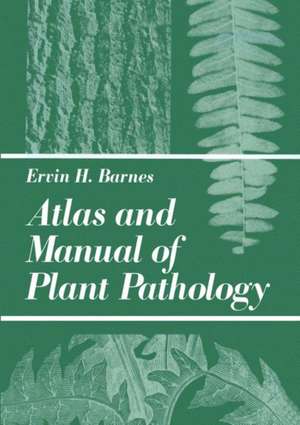Atlas and Manual of Plant Pathology
Autor E.H. Barnesen Limba Engleză Paperback – 31 mai 1979
Preț: 647.08 lei
Preț vechi: 761.27 lei
-15% Nou
Puncte Express: 971
Preț estimativ în valută:
123.82€ • 129.62$ • 102.45£
123.82€ • 129.62$ • 102.45£
Carte tipărită la comandă
Livrare economică 05-19 aprilie
Preluare comenzi: 021 569.72.76
Specificații
ISBN-13: 9780306401688
ISBN-10: 0306401681
Pagini: 344
Ilustrații: XVIII, 344 p. 206 illus.
Dimensiuni: 178 x 254 x 18 mm
Greutate: 0.6 kg
Ediția:Softcover reprint of the original 1st ed. 1979
Editura: Springer Us
Colecția Springer
Locul publicării:New York, NY, United States
ISBN-10: 0306401681
Pagini: 344
Ilustrații: XVIII, 344 p. 206 illus.
Dimensiuni: 178 x 254 x 18 mm
Greutate: 0.6 kg
Ediția:Softcover reprint of the original 1st ed. 1979
Editura: Springer Us
Colecția Springer
Locul publicării:New York, NY, United States
Public țintă
ResearchCuprins
1. Definitions.- 2. Interpretation of Microscope Observations.- 3. Principles of Sterile Technique.- Experiment I. Application of Sterile Technique,.- Experiment II. Media Preparation,.- 4. Bacterial Diseases.- 5. Bacterial Soft Rot.- Experiment III. The Germ Theory of Disease,.- Experiment IV. Examination of Diseased Tissues,.- Experiment V. Isolation of Bacteria,.- Experiment VI. Koch’s Postulates,.- Experiment VII. Inoculum Potential: An Epidemiological Factor,.- Experiment VIII. Pathogenesis: Tissue Maceration, by Pectic Enzymes,.- Experiment IX. Dispersal by Rain,.- 6. Fireblight of Apple and Pear.- 7. Common Bacterial Blight of Bean.- 8. Bacterial Wilt of Cucumber.- 9. Crown Gall.- Experiment X. Crown Gall,.- 10. Root Nodules of Legumes.- 11. Virus Diseases.- 12. Tobacco Mosaic.- 13. Potato Latent Mosaic.- Experiment XI. Biological Properties of Viruses—Local and Systemic Infections,.- Experiment XII. Biological Properties of Viruses—Synergism,.- Experiment XIII. Physical Properties of Viruses,.- 14. Aster Yellows.- 15. The Fungi.- 16. Club Root of Cabbage.- 17. The Oomycetes.- 18. Late Blight of Potato.- 19. The Downy Mildews.- 20. White Rusts of Crucifers.- 21. The Zygomycetes.- 22. Damping-Off.- Experiment XIV. Damping-Off: Inoculum Potential,.- 23. The Ascomycetes.- 24. Peach Leaf Curl.- 25. Dutch Elm Disease.- 26. Powdery Mildews.- 27. Hypoxylon Canker.- 28. Ergot of Grain.- 29. Black Leaf Spot of Elm.- 30. Sycamore Anthracnose.- 31. Beech Bark Disease-Complex.- 32. Tar Spot of Maple.- 33. Sclerotinia Diseases.- 34. Brown Rot of Stone Fruits.- Experiment XV. Brown Rot of Stone Fruits: Inoculation and Isolation,.- 35. Black Rot of Grape.- 36. Black Knot of Plum and Cherry.- 37. Apple Scab.- 38. The Deuteromycetes: (The Fungi Imperfecti).- 39. AlternariaDiseases.- 40. Botrytis Diseases.- 41. Fusarium Diseases:.- Experiment XVI. fusarium Wilt of Tomato: Isolation and Observation,.- Experiment XVII. Fusarium Wilt of Tomato: Effect on Transpiration,.- 42. Verticillium Wilt.- 43. Anthracnose.- 44. The Basidiomycetes.- 45. The Rusts.- 46. Stem Rust of Wheat.- 47. Hollyhock Rust.- 48. Cedar-Apple Rust.- 49. White Pine Blister Rust.- 50. Needle Rusts.- 51. The Smut Diseases.- Experiment XVIII. Oat Smut: Germination,.- 52. Wood Rots.- 53. Mistletoes.- 54. Dodder (Cuscuta).- 55. Nematodes: (Eelworms).






